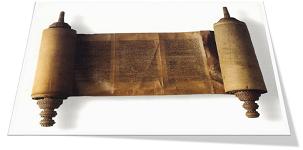The Belgic Confession of Faith Article 4 Canonical Books of The Holy Scripture – Books of Moses
The Belgic Confession of Faith Article 4 Canonical Books of The Holy Scripture – Books of Moses
In the two previous issues the subject of our discussion has been this 4th article, and we have not yet advanced further than the first sentence. Therein we have seen that the Bible is divided into two parts, namely, the Old and the New Testaments. But these can be further divided; the Old Testament contains 39 books and the New Testament 27 books. All the names of these books are mentioned in this article. You will understand that it is impossible to give a complete review of each book, but we will try to mention something about each of them.
The first book in the Bible is GENESIS, the first of five books written by Moses. (These five books are called the Pentateuch, meaning five.) Genesis tells us of the beginning of all things by the Word of God and also the origin of the children of Israel. It informs us of the birth of the heavens and earth and the human race; it speaks also of the fall and the promise of restoration by the seed of the woman, of the covenant made with Noah and later with Abraham. Genesis spans a period of about 2,369 years – from creation to the death of Joseph.
 EXODUS, the second book, means departure, and tells of the departure of the children of Israel out of Egypt. This information is important, in that it is the fulfilling of the Lord's promise to Abraham. His children were to be oppressed for a certain period in a strange country, but at last would depart from it with great treasures. In connection with this, Moses was born and was led in a special way in preparation for his task as mediator of the Old Testament, mediator between God and Israel. Here we see that Israel was chosen out of all the nations to be God's people. The period covered by Exodus is about 145 years, from the year 2369 to 2514, or from 1635 B.C. to 1490 B.C. (All dates are approximate.)
EXODUS, the second book, means departure, and tells of the departure of the children of Israel out of Egypt. This information is important, in that it is the fulfilling of the Lord's promise to Abraham. His children were to be oppressed for a certain period in a strange country, but at last would depart from it with great treasures. In connection with this, Moses was born and was led in a special way in preparation for his task as mediator of the Old Testament, mediator between God and Israel. Here we see that Israel was chosen out of all the nations to be God's people. The period covered by Exodus is about 145 years, from the year 2369 to 2514, or from 1635 B.C. to 1490 B.C. (All dates are approximate.)
In LEVITICUS, the third book, we find many religious laws and ceremonies, performed by the tribe of Levi, who took the place of the first born. We see the name of their tribe in the name of this book; literally it means "priest's book". It reveals the relationship between God and Israel. In the first part are the institution of the priesthood and the rules for cleansing and reconciliation. The second part contains the requirements of God for holiness in a number of commandments or laws.
The name of the fourth book, NUMBERS, is derived from the counting or numbering of the children of Israel in the wilderness. In the first part is told the history from Mount Sinai to Kadesh, where the people were condemned to wander for forty years in the desert. The second part tells of those forty years, and the last part tells what took place in the plains of Moab.
In this book there is also described the encampment of the Israelites in the desert. In their midst was the tabernacle, with Moses, Aaron and the priests to the east of it, the Kohathites to the south, the Gershonites to the west, and the Merarites to the north. Surrounding them were the tribes of Israel, totalling about two million people. How impressive this camp was. Now we can understand what Balaam said in Numbers 24:5 – "How goodly are thy tents, O Jacob, and thy tabernacles, O Israel."
The fifth book, DEUTERONOMY, meaning something like "second law", repeats the law, with several explanations or applications added to it. These are the five books written by Moses, with the exception of the last two chapters of Deuteronomy, which were probably written by Joshua.
Following these five books of Moses are twelve historical books from Joshua to Esther, which tell the history of the children of Israel during more than a thousand year period – from the death of Moses to the national reformation during the life of Nehemiah. This is from about 1451 B.C. to 439 B.C., or 1,012 years. These books do not follow in exact chronological order the history of Israel, but we do find that the history of Israel is the history of the revelation of God.
JOSHUA is the first of these historical books and is named after its writer. It reveals how Canaan was captured and divided among the tribes. It is a testimony of God's faithfulness in the fulfilment of His promises, but also of His wrath against the heathens. At the close of the book Joshua renews the covenant between God and Israel.
Next the book of JUDGES speaks of those men which were sent by the Lord time and again to deliver His people out of the hand of their enemies. The Lord had given them these judges because they forgot His institutions. When they cried to the Lord, He heard their supplications. Judges was probably written by Samuel. Some think that a period of about 300 years of Israel's history is related in this book, which I think is correct. To prove this we refer to 1 Kings 6:1, where it is mentioned that the time from the exodus or departure from Egypt to the fourth year of King Solomon was 480 years. Then we know of the following time periods –
Israel in the desert 40 years
Capture of Canaan until death of Joshua and elders 20 years
Until Othniel 20 years
Samuel was Judge before Saul became king 8 years
Saul reigned 32 years
David reigned 40 years
Solomon was then king for 4 years
Totalling 164 years
Subtracting this from the 480 years mentioned above, there will be a difference of 316 years. Therefore it must have been about 300 years of Israel's history covered by the book of Judges. If we count all the years of the judges, we will arrive at about 400 years. This means that there were times when more than one person judged Israel, just as it happened that there were at times more than one prophet in Israel.
Then follows the book of RUTH, which gives us the history of the Moabitess woman with this name, who came with her mother-in-law to the city of Bethlehem. It tells how she was incorporated in Israel and of the birth of David's grandfather. It is not known for certain who wrote this book, but some think that its author was also Samuel.
Then the TWO BOOKS OF SAMUEL continue on from where the book of Judges ended. First the restoration of the theocracy is described, then the kingdom of Saul is brought about, and finally the kingdom of David is established.
The TWO BOOKS OF KINGS display the development of the theocracy during the reign of the kings from Solomon until the exile in Babylon. The name of the writer is unknown, but he is probably one of the exiles, as would be evidenced by the last chapters of the second book.
The purpose of the writer of the next two books, the TWO BOOKS OF CHRONICLES, is to show that the keeping of the Lord's commandments are blessed by Him, but when He is forsaken, punishments are certain. At the end of the second book we find that Cyrus gave permission to the Jews to return to their own country. It is possible that these two books were written by Ezra, as the last part of the second book harmonizes with the beginning of the book of Ezra which follows.
EZRA, named after its writer, describes the history of the Jews after their exile and return to Canaan, with their many reformations.
The next book, NEHEMIAH, was also given the name of its writer, who was the cup-bearer in the court of Artaxerxes (or Artahsasta). Nehemiah received permission to rebuild Jerusalem. This book closes the history of the Old Testament in about the year 3584, or 420 years before Christ.
The last of the historical books is ESTHER, which takes its name from the woman whose history is related in this book. The writer is unknown, although it is evident that he is well-acquainted with the history of the Persian empire, and he may testify of the wonderful dealings of the Lord with Israel in protecting them from destruction by Haman. It is in this way that Esther the queen was used by the Lord.

Add new comment